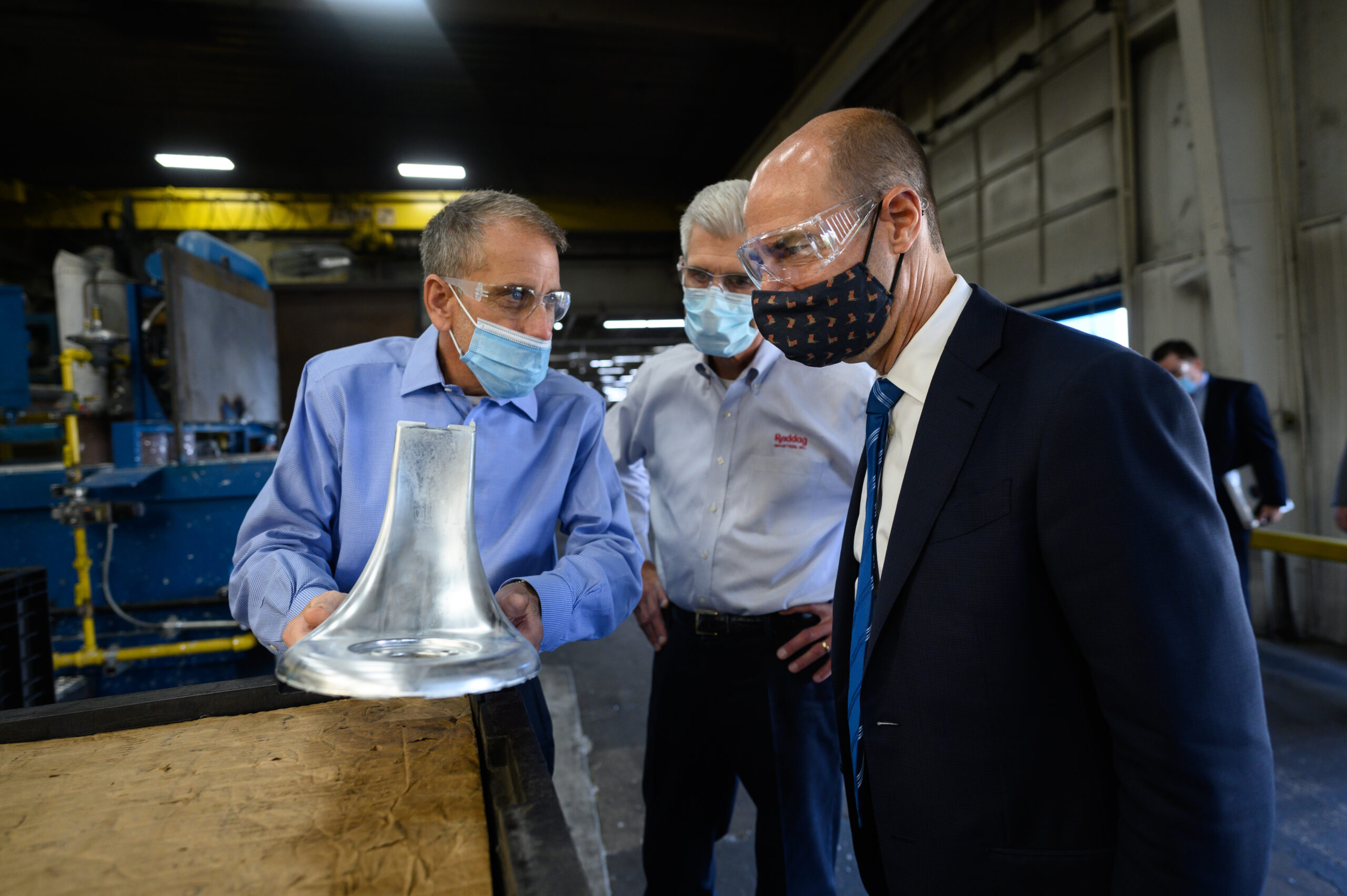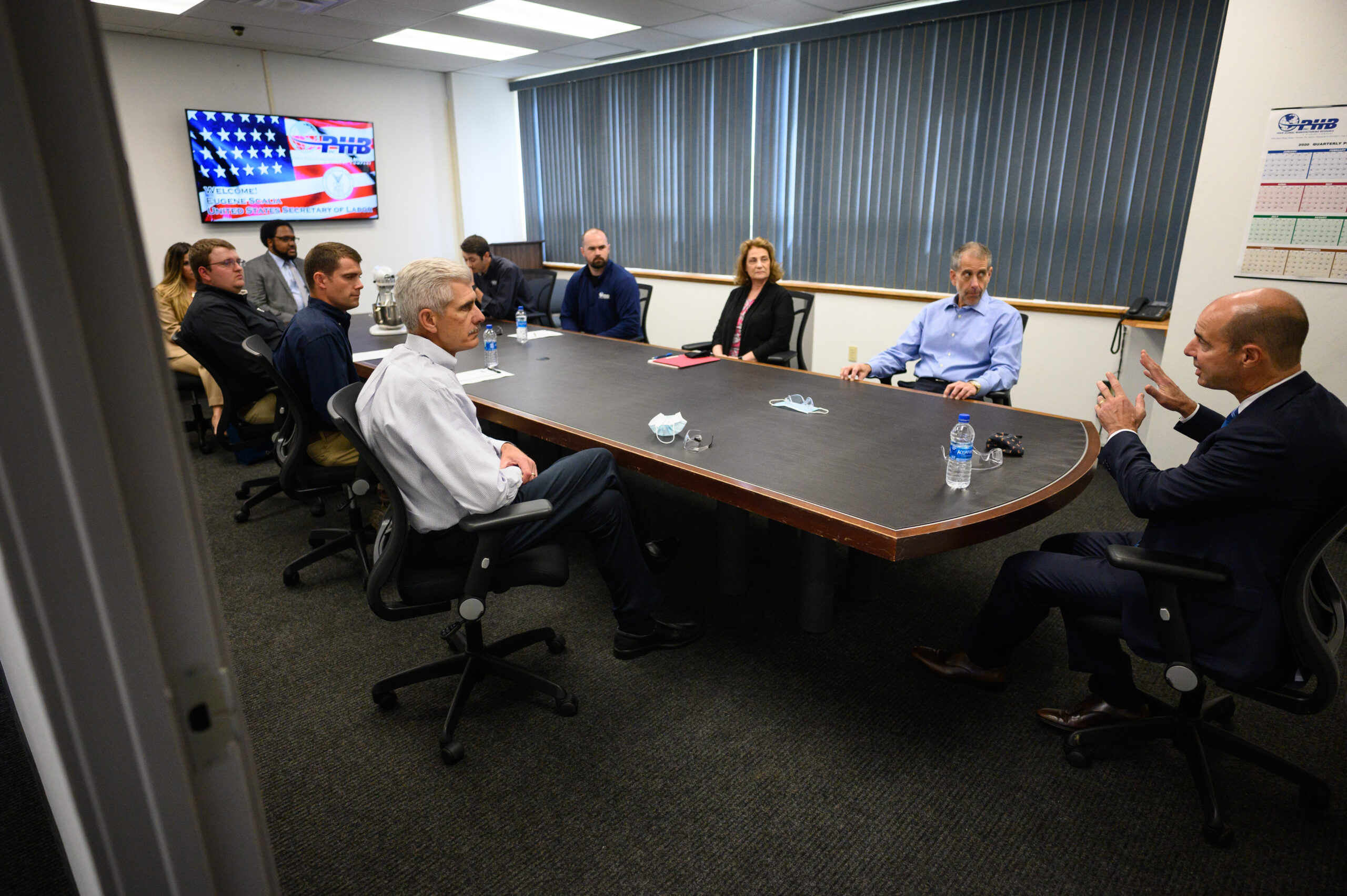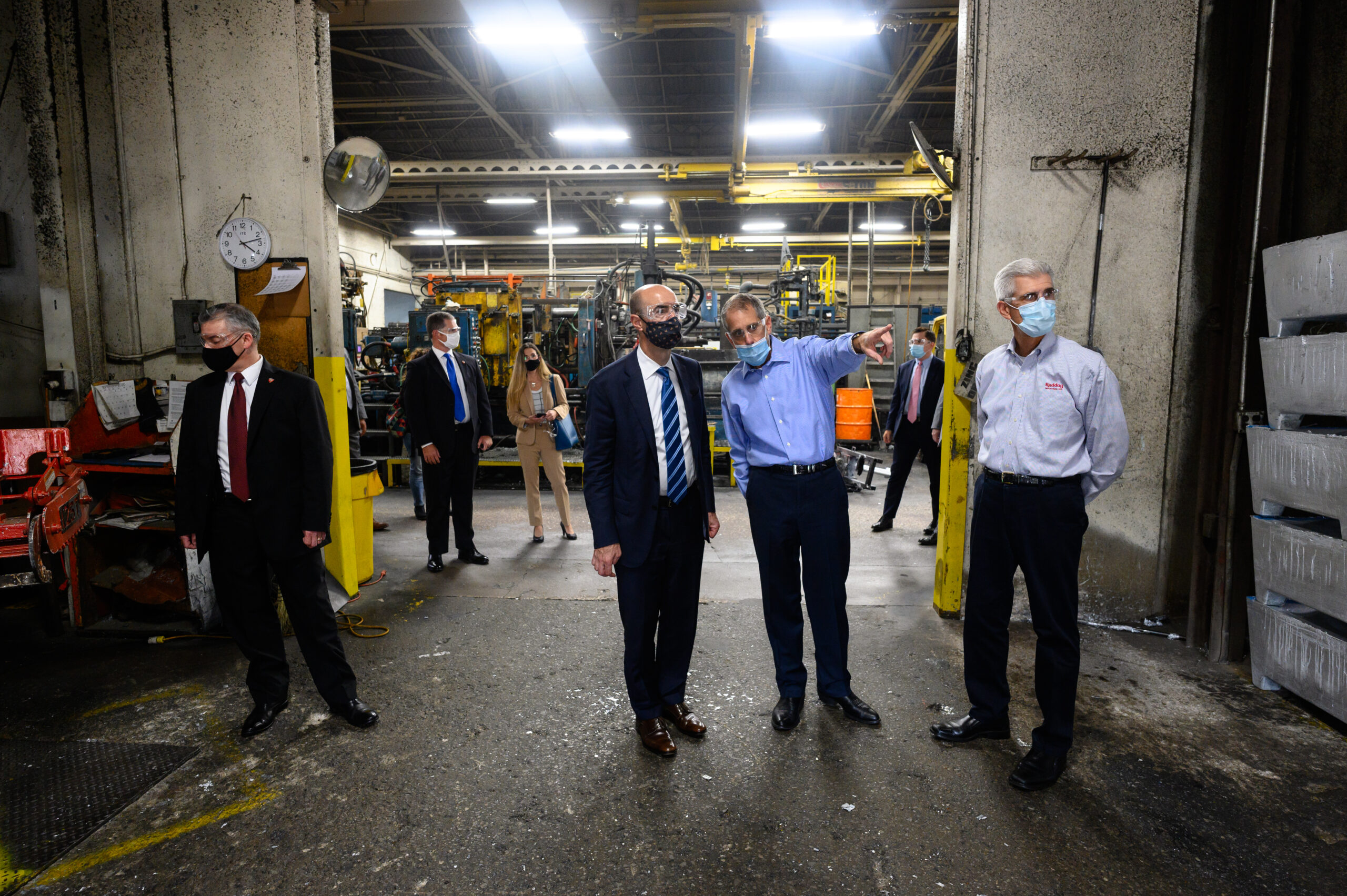FAIRVIEW, Pennsylvania — U.S. Secretary of Labor Eugene Scalia believes direct engagement can be more instructive than words on a page.
In an exclusive interview with the Washington Examiner, Scalia credited his experiences this week visiting manufacturing facilities in Cleveland, Buffalo, and Erie, Pennsylvania, with giving him more insight into how to keep the economy growing than any internal Labor Department document could.

“The days that I spent away from my office, meeting with businesspeople and meeting with workers, are among the most educational, valuable days that I spend,” said Scalia, a longtime top labor attorney and son of the late Supreme Court justice.
Scalia spent Tuesday in Cleveland then drove to Erie County PHB Industries, a 100-plus-year-old, privately held corporation that employs more than 500 people and is acknowledged across the globe as a fully incorporated supplier of quality parts and assemblies.
The company’s massive plant features 750,000 square feet of manufacturing floor space, with a whirl of aluminum die casting and zinc die casting in action along with a variety of product assembly done by a combination of workers, computers, and 3D printers. There, Scalia sat down with the owners of the facility to discuss the challenges they faced during the virus, the benefits and drawbacks of the latest presidential trade deal, and their apprentice program in high schools across this western Pennsylvania county.
The Labor secretary, who marked his one-year anniversary on the job Monday, also met with several students who had not only successfully completed their apprentice programs at PHB but also earned their way up to become leaders in the company.
Earlier in the day, Scalia announced that the University of Pittsburgh-Titusville was a recipient of a grant through the Workforce Opportunities for Rural Communities Program. These grants allow universities in rural areas such as Erie and nearby Venango County to train workers in the technical, medical, and industrial fields.
Manufacturing facilities such as PHB stressed to Scalia that they needed those skilled, trained workers to compete in the global market and operate their high-tech equipment. The company services many markets, including appliances, telecommunications, industrial equipment, electronics, electrical equipment, automotive, transportation, plastics, medical, aerospace, and defense.
Here is the full interview:

Washington Examiner: Cleveland, Erie, and Buffalo, what are you seeing as you’re visiting these places?
Scalia: Well, I’m visiting a lot of different kinds of workplaces, but a lot of it’s been focused on manufacturing. We’re particularly interested in the success of apprenticeship programs, and manufacturing is a sector where you’re seeing real investment in growth and apprenticeships.
It is fascinating to hear how companies decide that that’s what they want to do. It really is often companies who are looking to recruit, looking to bring more people in, but need a higher level of skill. So they’re attracting people to the company through a bargain, which says, “I’m going to teach you so that you can perform this really high-paying job, but you’ll also be doing some work here in the meantime.”
So you’ll be, as we say, earning and learning at the same time.
And at the same time, I’m speaking with young people, as you saw here, who are talking about how they learned about this thing that they maybe never heard of before and which their guidance counselor and parents were perhaps telling [them] was the wrong route, but for some people, it was the right route.
It was a way to gain almost immediate economic independence, to learn and also to put themselves within position in a year or two to three, to be in a really very good-paying job. I’m sure you know that apprenticeship jobs, once you’re through the program, on average, pay somewhere in the range of [$65,000] to $70,000 a year. So, they’d be really good-paying jobs.
I think you caught a little bit of the challenge that manufacturers and other employers sometimes have explaining to teachers, guidance counselors, parents, why this path in life can actually be incredibly rewarding. And of course, it’s not to the exclusion of going to college. At some point later, you often meet workers in these programs who, they do both.
So maybe they are in high school, and they start doing a pre-apprenticeship program or interning. They get out, they’re doing community college plus apprenticeship, and maybe a few years later, they complete a college degree.
Washington Examiner: Along with the economic component of this type of program, is there an emotional component in that they are able to stay living close to the things that have meaning to them, like family or traditions? Does this also help places like Erie County, which has lost a lot of population since the steel industry died, regain or hold onto population that might otherwise leave because of lack of jobs in their field?
Scalia: Often, what you see is a sort of bond that maybe already exists between the people that are in these programs, but that gets stronger. But another really important component of it is the bond between the mentor, the, that is, the highly skilled workers providing the training and that young person.
In fact, in this company I visited down near Cleveland, I met a fellow who was the coach for a particular program, probably a fellow in his 50s, but some of the young people were talking about how he was the reason they wanted to be there. Because he just a great teacher, had a great reputation. But you’re right. It’s also a way that, by bringing back some of these manufacturing jobs, by strengthening manufacturing in this part of the country, too, which been so important, yeah. You help families stay intact.
Washington Examiner: Leading up to COVID, things were — can you maybe give an outline for a reader to understand where we were, in terms of how strong our labor force was?
Scalia: Pre-COVID, we had one of the strongest economies the country’s seen. We saw more evidence of that in the Census Bureau report that came out earlier this month, which showed that median household income in 2019 had its largest increase ever. It was nearly a 7% increase. It worked out to about $4,400 a household. That’s a really significant increase for just one year. But in the same report showed that in 2019, we had the lowest poverty rate on record.
So we had the highest household median income increase and the greatest decrease in poverty. So, 2019 was an extraordinary year. And then, when you looked more closely at it, you saw that the greatest beneficiaries were populations that have had sometimes fewer opportunities in the workplace. Women had substantially higher wage increases. African Americans, Hispanic Americans, Asians, again, did better than the average.
We saw that also in the unemployment figures up through February, where we hit an all-time low for African American unemployment, less than a year ago. All-time lows for Americans with disabilities, Hispanics, other populations. A substantial majority of the new jobs that were being filled toward the end of last year were actually being filled by women.
And then, the wage increases, as you know, that we saw pre-COVID, were strong across the board, but they were actually highest in lowest, lower-paying jobs.
They’re the kind of jobs that we’re looking at here in western Pennsylvania. Blue-collar jobs where some of the really strong beneficiaries of this amazing economy that we had pre-COVID, which is why the president was calling it a blue-collar boom. But I really do want to underscore that I think that economy is within reach again soon. COVID was definitely a blow to the country in a number of different ways, and there were some very sad losses that came with it, but we’re rebounding out of that a lot more quickly than —
Washington Examiner: Quicker than you expected?
Scalia: I’ll give you some benchmarks. One is that when I said, in about May, that I thought we could get unemployment under 10% by the end of the year, that was perceived as highly optimistic, but here we are. August, we were well below 10% unemployment. Second, the Congressional Budget Office said in April that third-quarter unemployment would be about 17%.
We dropped it to 8.4%. And I think, in some ways, the most telling comparison is that in the last financial downturn, the so-called Great Recession, the financial crisis in 2008, 2009, unemployment remained 8.5% or higher for 34 months. It took Obama nearly three years to get unemployment under 8.5%. We got it under 8.5% in four months.
So, we’ve rebounded a lot more quickly. As the president has said, that’s partly because we had a strong patient, we had a really strong economy that has helped us come out more quickly. The legislation that the president and Congress put through in March, I think, was certainly helpful, the Paycheck Protection Program, very helpful to a lot of employers and workers. But obviously, there’s still more work to do. 8.4% unemployment is too high, and we’ll, as you know, have a new jobs report out at the end of the week. I think it’ll show we’ve continued to add jobs. So, we have work to do, but we’ve made a lot of progress.

Washington Examiner: How has the trade agreement and the tax cuts contributed to the robustness of the economy going into COVID and now coming out of it? Has it contributed at all?
Scalia: The president’s tax cuts and also his campaign to sharply reduce unnecessary regulatory requirements have had, I think, a huge impact on the economic growth that we saw. I think, you know that in part because before the 2016 election, not too long before the president came in, the Congressional Budget Office projected forward to the start of this year where they thought we would be. And they said, we’d add 1.9 million jobs. We added seven.
They said we’d be at 4.9% unemployment, and we were 3.5. So things really took off in those three years, and when I speak to business people, they tell me how important those tax cuts were in their making decisions to make substantial investments in new factories and the like, new equipment. And they tell me how important a more hospitable regulatory environment has been to those kinds of decisions. The USMCA [trade agreement with Mexico and Canada], I view as a bit like apprenticeships. As one of the things that we were working on pre-COVID, that is going to help us pull out of COVID.
It went into effect, USMCA did, July 1, and you see great enthusiasm for it in a number of different manufacturing areas and also agriculture.
I was in Wisconsin with the vice president last week, for example, which is going to benefit significantly from Canada lowering a number of the barriers it’s had to our dairy products.
Projections are that we’ll add around 75,000 auto manufacturing jobs, all told, as many as 500,000 jobs or more. So, I think USMCA projecting forward is going to be a really important part of the resurgence. And again, it’s the kind of job the president wants to bring back. He wants to bring back jobs. That was one of the very highest priorities from the day he came in. But he’s had a particular interest in bringing back these good-paying manufacturing jobs, which young people can enter and which they can spend a lifetime in and support a family on.
One of the things we spoke to the folks here at PHP about is what a manufacturing workplace is like today. There’s this perception that it’s going to be a very dark, gloomy, grim place.
But with the technology that you typically see now in American manufacturers, it’s really a pretty clean environment with some really extraordinary equipment that skilled operators are working with on a daily basis.
Washington Examiner: When you go out and you do these kinds of visits, you mentioned you went down in a coal mine and now this plant where you really saw some incredible work down first hand, is this field research for you and how do you bring that back into your job that is filled with numbers and data and paperwork?
Scalia: First, yup. Second, the days that I spent away from my office, meeting with businesspeople and meeting with workers, are among the most educational, valuable days that I spend. I hear from business leaders about what’s working in the economy from their perspective and what’s not. And I learned from the young people what drew them to a particular job, what skills they thought were valuable to have coming in, and sort of what their ambitions are. I also just happened to really enjoy speaking with young people.
Washington Examiner: You had this poignant piece you wrote at the passing of Justice Ginsberg that outlined your father’s friendship with her; explain why that was important for you to write?
Scalia: I felt fortunate to be able to write a piece where I told the world about this great friendship. And how much that had meant to my parents but also to me. And I concluded the article just talking about one night where I was at dinner with… It was New Year’s Eve, I was at dinner with the Ginsburgs and my wife, and just a couple of people were there. And I had this sort of, almost out-of-body experience where I just watched the four of them. It was wonderful.

